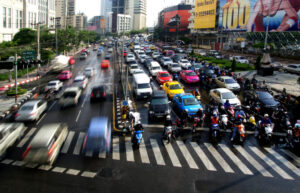With the help of the model created by Siberian specialists, it will be possible to find out in advance how the installation of a new traffic light, sign or construction of a traffic intersection will affect the speed of traffic flows.
Employees of the Institute of Computational Mathematics and Mathematical Geophysics of the Siberian Branch of the Russian Academy of Sciences have developed mathematical models and methods for the analysis and optimization of the urban transport network including go math 7th grade. They will help to make the traffic safer, reports Science in Siberia.
In the models, the input data are a city plan, information about the intensity of traffic flows, the existing restrictions for these flows and the number of objects, static and dynamic, that can be installed on the streets. Based on all this, the algorithm calculates what changes need to be made to make the movement of cars more efficient. The same models including https://argoprep.com/blog/k8/what-is-a-multiple/ make it possible to evaluate any proposal made to improve or reorganize the transport network – to understand how traffic flows will be redistributed, if, for example, put a new traffic light in one place or another, build a bridge or change the markings, as well as how far the “waves” of consequences will disperse from every such decision. Thanks to this, you can, for example, see if the installation of one traffic light will complicate the traffic situation on the route behind this object.
“We are launching a model of a nonexistent system and looking at how it will work,” says the head of the Laboratory for System Modeling and Optimization of the Institute of Computational Mathematics and Mathematical Geophysics of the Siberian Branch of the Russian Academy of Sciences, Doctor of Technical Sciences Alexei Sergeevich Rodionov. – In one such run, we can not only assess the effectiveness of the location of road infrastructure facilities, but also change the options until an optimal result is achieved. It got better – we continue, it is not – we return to the starting position, try a different version. ”
This method can be applied to an arbitrary transport network – it is enough to have the necessary information. It helps to get it that the data on car flows in recent years are recorded quite accurately: cameras tracking violations collect statistics on both the number and speed of cars.
Another part of the scientists’ research is directly related to traffic safety. Today, almost all modern cars are equipped not only with on-board computers, but also with on-board transmitters, which the driver may not even suspect about, such as the same ERA-GLONASS. An example of their use is automatic accident notification. If the airbags are deployed, the signal is transmitted to inform of the accident regardless of the driver’s actions. As soon as it reaches the stationary transmitter, information about what happened is immediately transmitted to the appropriate services, for example, to the traffic police. This is important because the driver and passengers may not always be able to call for help themselves.
However, there are situations when the car is too far from the roadside station (that is, a more powerful transmitter-receiver) and the relatively weak signal of the car does not reach it. Then road users begin to communicate with each other, relay the signal over the wireless network VANET (Vehicular Ad Hoc Network). A distinctive feature of such networks is a constantly changing topology, that is, the mutually changing position of all network nodes.
To alert about disasters, such as fires or floods, so-called sensor networks are used, consisting of a large number of sensors equipped with short-range transmitters and transmitters. If something happens, the sensors closest to the place of the event start transmitting a signal, which is further transmitted along a chain of other sensors to the base station, which is directly connected to the control center. Thus, the structure of information transmission is created every time in the most convenient way. In the situation with the road, the situation is exactly the same, only in this case the objects (cars) are not stationary, but are in motion.
If vehicles interact not only with infrastructure, but also with each other, signal transmission efficiency is enhanced. Sometimes feedback is also required – for example, when you need to promptly notify road users about emergency situations on the roads (road accident, landslide, avalanche, wire breakage).
Now satellite systems play a similar role, but they are much more expensive and cannot always reliably transmit a signal to the planet’s surface (clouds can interfere with the signal transmission). Moreover, the number of satellites is limited, and the shutdown of one of them (and such a case is always better to foresee) leads to the failure of a huge number of connections below – damaging the system on earth is much more difficult.
In order for the communication and notification system to work effectively even without satellites, it is important to determine the number and location of stationary base stations across the city, from which the signal will be guaranteed to be transmitted to the required services. The method developed by mathematicians helps to do this. This also requires a city plan and traffic data. For example, according to experts, it is enough to install six stations in Akademgorodok – this number is enough for the signal to be promptly transmitted to the appropriate services in a short time.
The software kernel created by the developers is universal. At this stage, an algorithm has already been created, the reliability of its operation has been checked, and a program has been written that allows the algorithm to be applied to different sets of incoming data. But the final product requires cooperation with companies that have programmers who will clothe all this in a user-friendly graphical shell.
